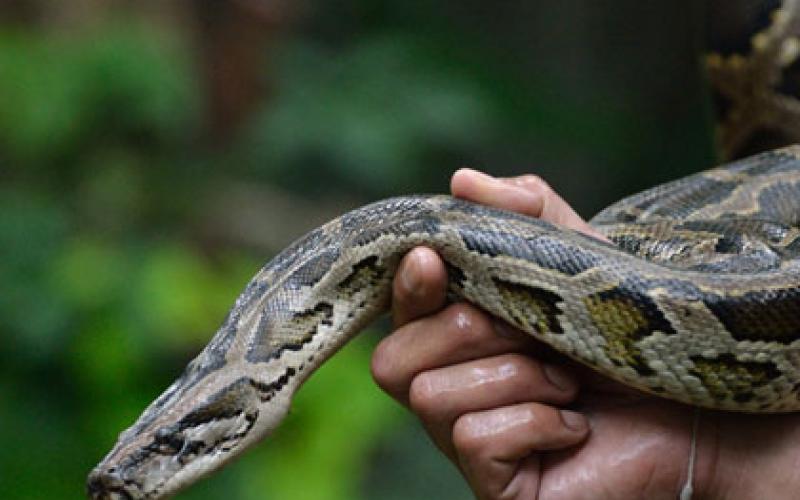Invasive snakes threaten biodiversity in Florida

Invasive snakes threaten biodiversity in Florida
The invasive Burmese python has been linked to mammal declines Florida's Everglades National park. Researchers fear that some of the endangered species of the region may be in danger.
Michael E. Dorcas, John D. Willson, Robert N. Reed, Ray W. Snow, Michael R. Rochford, Melissa A. Miller, Walter E. Meshaka, Jr., Paul T. Andreadis, Frank J. Mazzotti, Christina M. Romagosa, and Kristen M. Hart, "Severe mammal declines coincide with proliferation of invasive Burmese pythons in Everglades National Park,"Proceedings of the National Academy of Sciences, Published ahead of print, January 30, 2012 (2012), 1-5. DOI: http://dx.doi.org/10.1073/pnas.1115226109
The Burmese python is a constrictor from Southeast Asia that has found its way from pet stores into Florida's Everglades National Park. Officials first observed it in Florida's wilderness in the 1980s and it was considered officially established in the year 2000. The pythons prey upon a diverse set of animals that includes birds and mammals and even alligators. They have proliferated since their establishment, expanding their range to the point that running across a python has become a common occurrence.
A group of researchers has examined the effects that the pythons are having on local mammals and their results appear in the Proceedings of the National Academy of Sciences. The team, led by a biologist from Davidson College, conducted surveys of Everglades National Park from 2003 to 2011. They compared their findings to data from surveys conducted in the 1990s, before the snakes began proliferating. The scientists found that raccoons, opossums, and bobcats were markedly less abundant, with the frequency of their sightings having decreased by 99.3 percent, 98.9 percent, and 87.5 percent, respectively. Overall, the frequency of medium-sized mammals sightings had decreased a lot, with a slight increase in the number of small rodent sightings. The losses were most pronounced in regions where the pythons had been around for longer.
The pythons seem to be having an effect on the local food web of the Everglades. Because the pythons have found conditions where they can thrive, their pressure on the ecosystem could change its fundamental food-web dynamics. This is bad for conservation because it means that the populations of prey species can be reduced and even competitor species, such as the panther, could become less abundant. In other cases, however, the pythons might increase the numbers of small rodents because the snakes eat their larger predators—so an understanding of the effects is still unfolding.
The effects could have legal consequences, as well. The Everglades contain threatened and endangered species that are listed under the Endangered Species Act. Now that the delayed effects of this invasive snake are coming to light, managers can use the knowledge to better protect the biodiversity of this unique national park.




